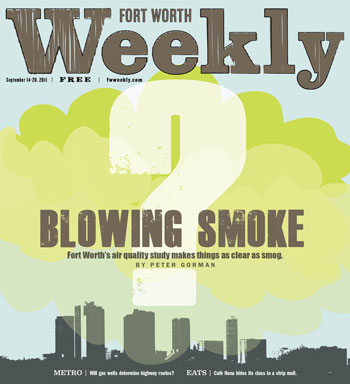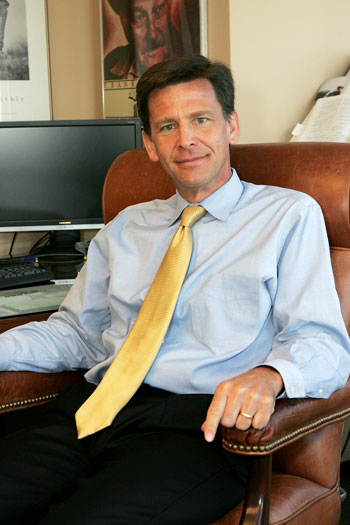What if you brought your car to a mechanic for a tune-up and he looked it over and said it was in good shape. But then he told you he hadn’t actually checked whether it needed oil, just made a guess based on a chart of cars of similar make and age. And he tested the wear on one tire, so he assumed all four were OK. And he hadn’t checked the transmission because you’d only paid $100 for the checkup and he’d run out of labor-time to investigate those systems. Would you be happy with that or would you want to wring his neck?
That’s the way a lot of people feel about Fort Worth’s recently completed air quality study. Commissioned by the city council to assess the impact of gas drilling on residents’ health, the final report is being hailed in some quarters as a template for future studies.
“We’re pleased because this was the first study ever done really on-site like this,” said city public information officer Jason Lamers, though he admits it could have been more comprehensive. He noted that the study addressed overall air quality as well as specifically testing emissions from gas facilities. “That’s what we were trying to find out — what is in the air we’re breathing here in Fort Worth.”
 But others fear that the study, released in July, will be taken as the final word on local air quality and that, because of huge gaps in the way the study was conducted, will allow the drilling industry to continue to pour enormous quantities of toxic emissions into the air while pointing to the study as proof that there’s nothing to worry about.
But others fear that the study, released in July, will be taken as the final word on local air quality and that, because of huge gaps in the way the study was conducted, will allow the drilling industry to continue to pour enormous quantities of toxic emissions into the air while pointing to the study as proof that there’s nothing to worry about.
Figuring out who is right is difficult because the report is 320 pages of technical information, scientific jargon, chemical values, and emissions modeling that only a scientist in the field could understand. Even people who are knowledgeable and passionate about drilling give up halfway through.
Produced by the Eastern Research Group, the report provides more data than has ever been available about what is in the air we’re breathing — more than 140 chemicals including known carcinogens like benzene and substances like xylene that are classed as hazardous air pollutants. ERG did not respond to repeated requests for comment.
ERG tested 388 gas industry-related sites around the city and found that the vast majority of them are producing toxic emissions at some level. However, the researchers found that only five of 388 facilities were emitting chemicals in quantities large enough to be potentially dangerous. Their bottom line conclusion: No one in Fort Worth is in any immediate danger from gas drilling operations.
“Call me a skeptic,” said Gary Hogan, “but I think the whole study was choreographed to get the result that former Mayor Mike Moncrief wanted when he commissioned it: Which was to say that gas drilling in Fort Worth isn’t causing harmful pollution.” Hogan served on the two drilling ordinance committees under Moncrief.
The scope of what ERG acknowledges it didn’t study is as instructive as what it found. For instance, although the researchers visited 375 well sites, they saw only one that was engaged in drilling. And only one where fracking was going on. As a result, they decided they didn’t have enough information to draw conclusions about emissions from either fracking or drilling — the two stages in the life cycle of a well that produce the highest volume of short-term pollution. ERG also studied emissions at eight compressor stations, the city’s only treatment facility for toxic wastewater from drilling, and one completion operation (when the well tubing is cemented in place and the well is readied for fracking).
In fact, although the ERG teams visited compressor stations — generally the source of more pollution than any other type of gas industry facility — they didn’t actually include the high emission rates they found at three of them in their final data. Instead, they estimated the emissions based on vendor data and other people’s reports. Nor did ERG’s estimate of pollution levels take into account the emissions typically produced by gas storage tanks when the tanks experience temperature or pressure changes.
Fort Worth attorney Jim Bradbury said the report didn’t provide the answers it was supposed to. “While we now have information that we did not have before, we do not have the clear-eyed answers that we need,” he wrote in a letter to Mayor Betsy Price and council members.
Bradbury was one of several citizens appointed to the committee that developed the areas to be studied and then selected the company to perform the study. The panel, which included state and federal regulators, industry members, and citizen representatives, spent four months setting up the scope of the study. The contract was put out for bid, and ERG was selected from among nine companies.
However, around the time Eastern Research Group was selected, Bradbury said, “communications got very strained between city staff and the committee, and the city went into private negotiations with ERG. So from that point on, it became a city staff operation.”
The result, he said, was that while the broad scope of the study design remained in place, “the methodologies and completeness were different than what we initially wanted.”
The city asked ERG to answer four questions about air quality in Fort Worth: How much air pollution is being released by natural gas exploration in the city? Do sites comply with environmental regulation? How do emissions from these sites affect off-site air pollution levels? And are the city’s required setbacks from inhabited buildings for these sites adequate to protect the public health?
To answer those questions, ERG performed an ambient air study to discover what’s generally in the air in Fort Worth, took on-site emissions readings from 388 natural gas facilities, evaluated the health risks posed by those emissions, and projected what gas industry emissions would be like once the city’s natural gas field has been fully developed.
The study was broken into two phases. In one phase, canisters were placed at eight stations around the city to collect 24-hour air samples every three days during September and October 2010 and again in January and February 2011. Those samples were intended to paint a picture of overall air quality.
In the second phase, teams visited gas sites around Fort Worth and used infrared cameras and other equipment to detect on-site emissions. Where leaks were discovered, air samples were collected and analyzed for their chemical components.
The overall picture painted was that while the majority of sites surveyed produced toxic emissions, only five sites — a processing facility, three of the eight compressor stations visited, and one well pad — produced emissions over what is permitted.
Problems at those sites, along with most of the other emissions discovered, could be mitigated, the researchers said. The mitigation could be done with vapor recovery systems, the use of electric (rather than diesel) motors on compressors, installation of low-bleed pneumatic valves to regulate gas flow on some equipment to prevent fugitive gas emissions, and what are called “green completions” — when drilling wastes are removed before a well is fracked, rather than allowing them to escape to the environment. The researchers also recommended better inspection and maintenance of natural gas sites to reduce emissions.
“That’s the one part of the report I completely agree with,” said Hogan. “Those are the basic things that both activists and the Environmental Protection Agency have been asking to make requirements for a long time.”
Critics charge that the report leaves major and potentially dangerous gaps in the knowledge about what local residents are breathing. Not gathering actual emissions data from compressor stations was only one item in a long list of limitations that ERG acknowledged in its data gathering.
ERG also chose not to investigate gas and toxic emissions that occur in dehydrators when water is removed from the gas, the toxins that escape into the air when chemical-laden frack water returns to the surface, and flaring — the burning off of gas when wells are initially completed. Also not measured were “non-routine emissions” such as those generated during upsets or from maintenance, start-up, and shutdown activities, unless such emissions were observed at the time of the site visit.
Those kinds of emissions occur with some regularity in the shale field, but — as with the 300-plus wells that happened not to be undergoing either fracking or drilling when investigators came by — none of those incidents happened during the ERG testing period. To some observers, it seems rather like gauging highway safety by leaving out all reports of actual traffic accidents.
 “These are big omissions,” said Ramon Alvarez, a scientist with the Environmental Defense Fund in Austin and a member of the Fort Worth Air Quality Committee. Both the routine pollution from equipment and the non-routine events “could have had a significant effect on the testing results,” he said.
“These are big omissions,” said Ramon Alvarez, a scientist with the Environmental Defense Fund in Austin and a member of the Fort Worth Air Quality Committee. Both the routine pollution from equipment and the non-routine events “could have had a significant effect on the testing results,” he said.
There are other holes in the ERG study as well. According to the report, many pollutants normally associated with gas drilling and production activities did not appear in the ambient air studies and therefore the study “did not consider the complete range of air pollutants that might be emitted from natural gas sites.”
Nor did the study take into consideration the problems known to be caused by combinations of the various chemicals spread in the air by drilling activities. “Many of the pollutants emitted at the well pads and compressor stations are known to react in the air and form other pollutants,” ERG researchers said, “and this was not considered in the modeling analysis.”
Alvarez said that he and other committee members expected much more comprehensive results than what they got. “I think the expectation of a majority of committee members was that we were going to get measurements done on a full life cycle of a well, from developing the well pad to drilling, fracking, completion, and production,” he said. “I think that’s a real shortcoming of the study.”
Overall, said Alvarez, “You cannot conclude that this study is comprehensive. To their credit, ERG was very explicit about what they didn’t include … . But that also means that a great deal more data needs to be collected in Fort Worth to find out what is really in the air here and what will be in the air” that could cause long-term problems.
Other scientists said they were equally surprised at some of the study’s limitations.
ERG’s work may be a start, but “several more issues would need to be addressed before this study would be a model for other studies,” said Melanie Sattler, who specializes in air quality consulting. She said the facilities looked at by ERG did not provide “a representative sampling of drilling, fracking, and injection well sites, because they only sampled one of each. In terms of condensate tanks, not sampling in the summer eliminates the worst case of emissions from those.”
And, she said, the eight ambient air sites tested don’t necessarily represent “what the people of Fort Worth are breathing on a daily basis.”
Eduardo Olaguer, director of Air Quality Research at the Houston Advanced Research Center (HARC), a nonprofit foundation, said his greatest concern was that ERG ignored “non-routine” emissions such as occur during maintenance, start-up, and shutdown of machinery.
“Unforeseen and/or planned emission events, as opposed to routine emissions, may be the real issue behind public complaints related to human exposure and adverse health impacts,” he said in an e-mail.
Olaguer said that simply estimating emissions from natural gas and diesel engines used in gas production, based mostly on vendor specifications, is risky. Engine maintenance, he noted, could conceivably result in “much greater temporary and cumulative emissions than ‘worst-case’ handbook estimates based on regular emissions.”
Similarly, he said, petrochemical facilities in the Houston Ship Channel often emit large quantities of chemicals in a few hours, but those dangerous periods of emissions no longer look significant when emissions are averaged over a year.
Ed Ireland, executive director of the industry-funded Barnett Shale Energy Education Council in Fort Worth, agreed with Olaguer that ERG’s estimating of emissions weakened the study — but for different reasons.
“They didn’t take into account the emission-control devices that are in use by regulation, which means they overstated the actual emissions. That was my one problem with the study,” he said.
Rick Trice, assistant director of Fort Worth’s gas well office, said ERG would have done better to actually measure compressor station emissions, but that there wasn’t anything particularly wrong with estimating. “It would have been good to model the emission controls on the diesel compressor stations,” he said. “But the fact that the models ERG [used] assumed the worst case, well, that was a good thing.”
Alisa Rich has many concerns about the study, including one that is pretty simply expressed: “People don’t breathe individual chemicals,” the owner of Wolf Eagle Environmental said. “They’re breathing them all at once.”
Rich was talking about how the ERG study measured individual chemicals but did not address the cumulative effect of having so many toxins in the air together. Her company specializes in air emission studies, including several major ones in the Barnett Shale.
“A one-hour exposure rate to one chemical might not exceed what your body can handle, [but] what happens when there are lots and lots of them?” she said. “Maybe acetone at a certain level won’t kill you, but combine that with benzene and toluene, and now what do you face? These are multiple, long-term exposures.”
Olaguer agreed. “One of the great unknowns … is the combined effects of complex mixtures, as opposed to single pollutants,” he said. “We remain ignorant of how to quantify or address this important issue.”
Rich also questioned ERG’s actions in allowing some of the air-sample canisters to sit for up to 30 days before being tested. By that time, she said, some important chemicals could have deteriorated.
“Everything starts to break down the minute it’s collected in that canister. The longer you wait, the more you lose concentrations of those compounds,” she said. “We don’t know exactly how much but we do know they deteriorate, and so holding them a month means you are losing a percentage of all those compounds, particularly the most volatile ones.”
She also suggested that ERG didn’t test far enough away from gas facilities to get a good reading on air pollution effects. When chemicals are spewed into the atmosphere, they travel for a distance before they settle out — like water from a hose under pressure. Rich said ERG’s dispersion model didn’t account for that.
“In my experience, the bulk of those chemicals fall about 2,000 feet from their point of release,” she said, whereas ERG stopped testing at 600 feet. (ERG concluded that the city’s 600-foot setback for gas wells is more than adequate.)
 Wilma Subra, a noted chemist and environmental scientist, agreed with Rich’s assessment. “We often find that a fence-line community, those closest to the emissions, gets some impact from pollution emissions, but five blocks away is where we find people getting a much higher level of those pollutants. Something like benzene is much more likely to come down 2,000 feet away from the emission point than at the fence line.”
Wilma Subra, a noted chemist and environmental scientist, agreed with Rich’s assessment. “We often find that a fence-line community, those closest to the emissions, gets some impact from pollution emissions, but five blocks away is where we find people getting a much higher level of those pollutants. Something like benzene is much more likely to come down 2,000 feet away from the emission point than at the fence line.”
Another aspect of the report that is drawing heat is the discussion of what the air in Fort Worth will be like once shale drilling in the city is completely built out. ERG modeled emissions over the next eight years and came to the conclusion that gas-related pollution will rise slightly in 2012 and 2013 and then begin to subside.
That sounds like, by the time shale development is over, gas-related air pollution won’t be much worse than it is now. But ERG’s definition of “fully built out” is highly misleading. The researchers used the term to mean that all the well sites now operating would continue to operate, along with other facilities that are now in the process of being built.
In reality, drilling activity in Fort Worth may reach three times the current level. According to recent statements from the city and Chesapeake Energy, less than 30 percent of the drilling and other industry operations planned for Fort Worth have yet been completed.
“Aubrey McClendon [CEO of Chesapeake] recently said Fort Worth was only 15 to 20 percent drilled,” said Don Young, a Fort Worth activist who has been fighting urban gas drilling since the first well was proposed. “And the air is already unacceptable. What’s going to happen when our 1,600 wells become 4,000 or when we have 100 compressor stations in the city?”
According to Bradbury, the study committee made clear what they intended for ERG to look at. “I was disappointed. The scope called for a full build-out estimate of pollutants. But you look at what they did, and you see ERG’s results are very minimal because it was based on currently operating or permitted sites.”
Another problem with the report is that ERG considered only short-term health issues related to gas drilling pollution and none of the long-term effects of repeated exposure to the toxins.
Michael Honeycutt, who is chief toxicologist for the Texas Commission on Environmental Quality, said the pollution guidelines now in use already take long-term exposure into consideration, as well as the greater sensitivity of groups like children, the elderly, pregnant women, and people with other health problems.
Larry Lowry, a professor at the University of Texas Health Science Center in Tyler, disagreed. He said the effects of gas industry-related air pollution on those groups has never been adequately studied.
“We need a scientifically designed study to see what the real health effects of these pollutants are, and unfortunately no one has paid to have it done, and certainly the petrochemical companies are not going to sponsor one,” he said. “So what do we have? We have guesstimates developed to try to evaluate safe and unsafe amounts of these pollutants. But that’s what they are — guesstimates.”
Neil Carmen, a scientist working with the Sierra Club’s Lone Star Chapter who previously worked with TCEQ for 12 years, said that any exposure to chemicals like benzene is potentially dangerous.
“For known carcinogens, the only safe value of exposure is zero. Any more than that, and you’re putting people at risk,” he said. “With gas drilling, people are being exposed to toxic soups, and we have no idea what these toxic soups do to the human body in the long term.”
Fort Worth Mayor Betsy Price, who took office the day before the air quality study was released, said she sees its flaws but thinks the city can use the report to improve the air quality.
“First, I’m pleased because there are no immediate risks to public health,” she said. “But there are things we can do to mitigate the pollution. We need to implement best practices on drilling. We need more maintenance on equipment and more oversight by the city.”
The city’s gas drilling ordinance, she said, can be changed as needed. “The welfare of our citizens has got to be our number-one priority. But the more we get into drilling, the more issues arise, so the more we will have to update our ordinance to resolve those as quickly as possible.”
Jerry Lobdill, a retired physicist who has been active in researching the Barnett Shale, had a much more cynical view. “The study is exactly what I knew it would be from the beginning — a farce and a fraud and a waste of $1 million.”
Esther McElfish, founder of the North Central Texas Communities Alliance and an outspoken critic of the way gas drilling is being done in Fort Worth, called the report “at best a very watered-down version of the way things are.”
“The city is going to be here a long time,” Bradbury said. “People are going to be exposed to these emissions for a long time. And this study does not answer the question of how that exposure will affect them.”












[…] (failed) $1 million dollar air study that Ft Worth did years ago* (read my 2011 response to TCEQ of the Ft […]